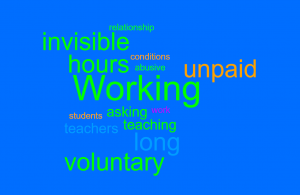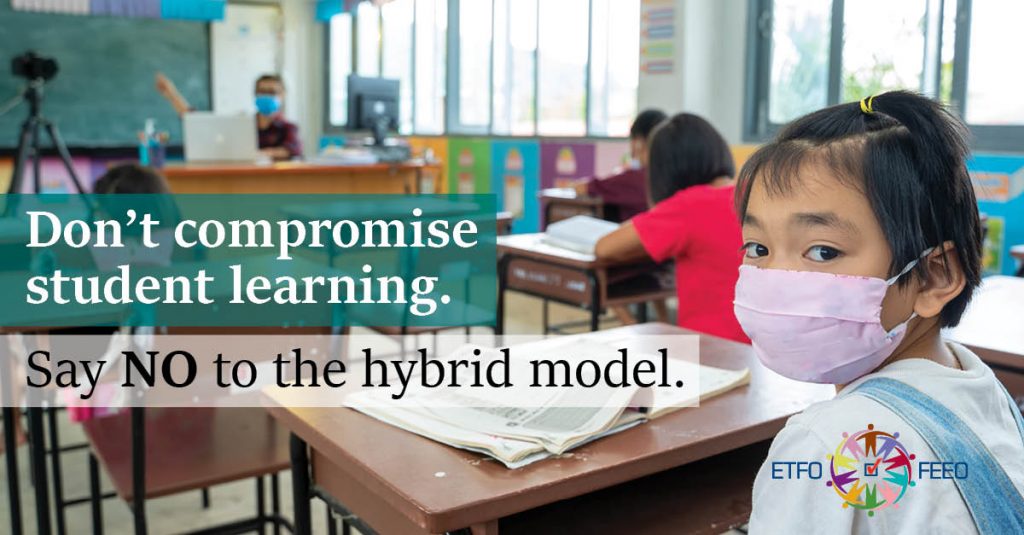
ETFO’s position on in-person learning remains unchanged. The union firmly believes that the daily, in-person model of instruction and support best meets the educational, developmental and social needs of students, provides the best experience for support, and is the most equitable learning model for all students. ETFO’s expectation is that elementary virtual learning in any capacity, including through hybrid models of instruction, will end once the pandemic ends.
In the time of Covid-19, feeling like I am working all the time has become a regular part of my existing.
Spring 2020
In the first lockdown, I was working 7 days a week, planning, instructing, and assessing. My learning curve was steep as I was developing skills in teaching through an online classroom via video sessions and learning how to organize my classroom instruction and assessment through technology. As I look back, these skills, now attained, seem so straight forward. The end of the school year in June 2020, was a welcome time for me as I could finally relax and have time away from screens.
Fall 2020
The September 2020 hit. Almost every day, policies and procedures changed. At one point I gave up reading board emails as the absorption of information taxed my executive function and in the end was futile as information changed. Instead, I asked the office staff for the “latest” updates thus sidestepping the need to read pages of email text.
As I had anticipated a future lock down, I set up my contained special education classroom practices to be virtual in nature. This meant that I could easily flip to teaching solely online if needed. Weeks into September, I was informed that I would also be teaching students synchronously online while teaching my students in class. Naïve, I thought flipping back and forth would be something I could handle. But it wasn’t.
Hybrid teaching and learning with inadequate technology
With students both online and face to face, my classroom calendar became the classroom hub. I set video links for the online students to join our class. There were a few significant barriers I had to overcome. Technology (i.e. equipment) needed was not provided, nor was the tech support to align my synchronous instruction needs. At one point, I was using a Chromebook as a microphone and camera in order to facilitate my online students seeing and hearing me and the rest of the class. There were many failed configurations that often resulted in echoing feedback. It was a very frustrating time for my students and me.
Welcome Mike
Finally, I decided to purchase a microphone for my school computer. The in class microphone, now called “Mike”, was a stress saviour. Now, our class could interact with students at home with ease. I left the video link open all day so students at home could reach out to me for help while we worked in class. They even asked to go to the bathroom!
In late October, my board provided our class with additional teacher support to work with students at home. The online students did not receive direct Physical Education, Health, Art, and Music (i.e. PHAM) instruction and were left with no teacher instruction as I was on my planning time.
Extra support is not always helpful
I welcomed this additional support for my students, at first. But the configuration and constraints set out by my board had the teacher providing online support to my students before our school’s first bell (i.e. students were set to receive instruction outside of school hours.) There was also a suggestion that I change my schedule, yet again, to accommodate this additional teacher support. It was late October. After changing my schedule over 6 times, I had finally found a schedule that supported all planning and curriculum requirements. I refused to change it again. After several weeks, the online support teacher was working with my students in a time period that met everyone’s needs … without a change to my schedule.
Stress increased risks to health
During the spring 2020 lockdown, I noticed new symptoms with my stomach. I attributed these symptoms to my existing diagnosis of gastritis and being more sedentary than usual. Between July and August, my symptoms faded away.
Once September hit, my symptoms made themselves known, getting a little worse each day. I experience regular pain in my abdomen and was exhausted all the time. I avoided possible triggers such as alcohol and fried foods but the symptoms became increasingly more disruptive, causing me pain that prevented a restful sleep.
On the phone, I talked to my doctor about my symptoms and we agreed to increase my stomach medication. This did not resolve the pain. Finally, I went to the hospital. The emergency doctor asked me why I had not contacted my family doctor about the pain. I told her I had but my doctor was not able to palpitate my abdomen … over the phone. Blood tests and a CT scan revealed an issue with pancreatitis and irritable bowel syndrome.
As I eat well and take care of my health, I wondered why I was experiencing this painful and fatigue inducing diagnosis. I then realized the obvious cause … stress.
Establishing boundaries to preserve physical and emotional health
Since my trip to the hospital almost 2 months ago, I still have symptoms. But I am feeling better and have more energy. My diet is very limited and I cannot eat very much at a time. I’ve lost over 20 lbs … don’t worry I am not a skinny person.
As a result of my health issues, I have purposely limited the time I spend on school work. Last weekend was the first weekend since teaching during Covid, that I took an entire weekend off. I have also taken up my cross-stitching hobby and listening to books. Herbal tea with a touch of honey is also very soothing. I find that when I do choose to work on my teaching practice, I am much more focused and effective as I am making fewer errors in my online classroom planning.
The time I’ve spent, being purposefully relaxed, has helped me manage my work as a teacher. In putting my own needs first, I am able to support my students more effectively.
It is my hope that teachers who read this blog will take more time for themselves so they can be there for their families and their students. If teachers do not care for their own needs, they could face burnout or challenges with physical and/or emotional health.
As Audre Lord states
“Caring for myself is not self-indulgence. It is self-preservation and is an act of political warfare.“
Take care of yourself before you care for others,
Deb Weston, PhD



